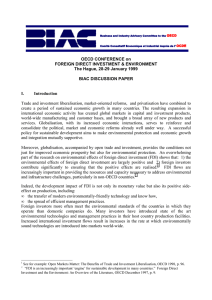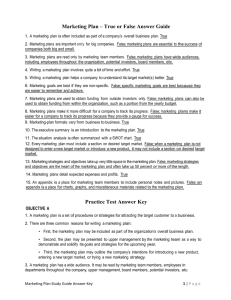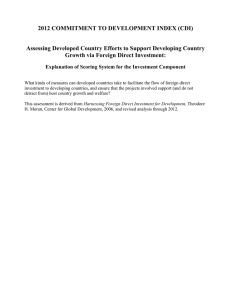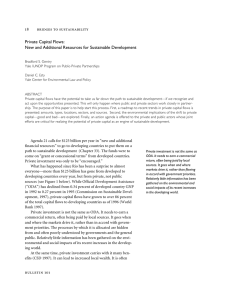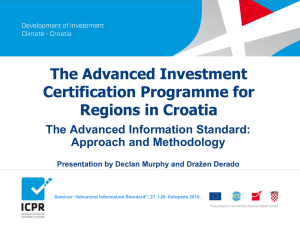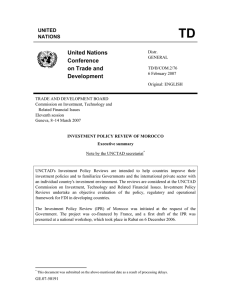Appendix S4: Countries in Sample
advertisement
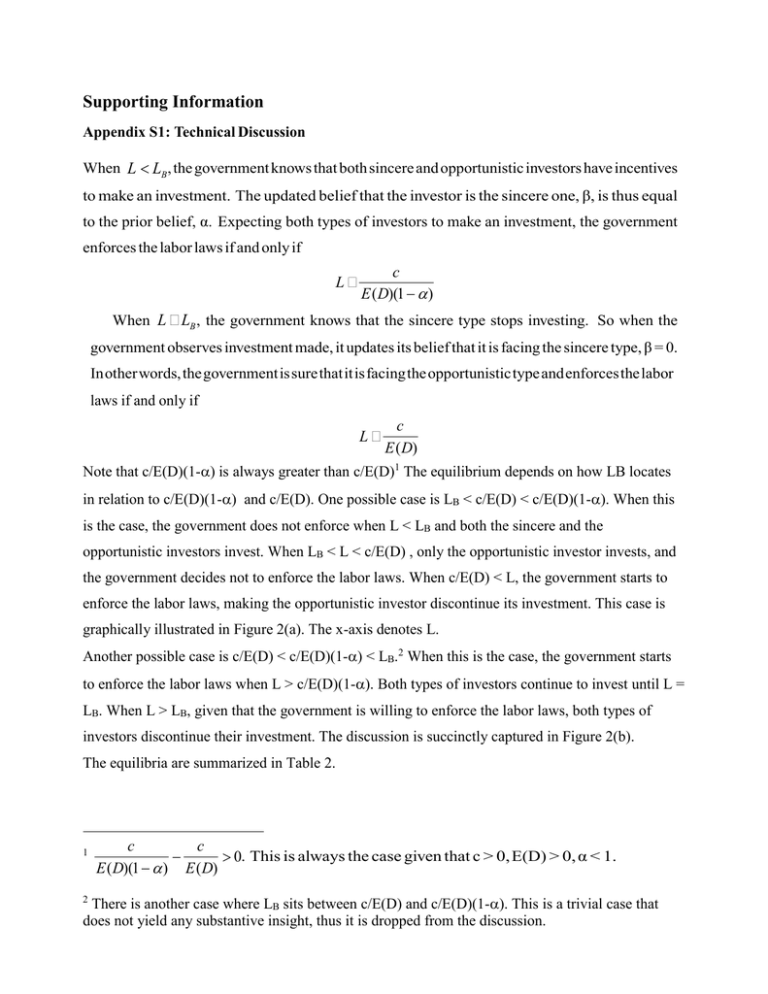
Supporting Information Appendix S1: Technical Discussion When L < LB , the government knows that both sincere and opportunistic investors have incentives to make an investment. The updated belief that the investor is the sincere one, β, is thus equal to the prior belief, α. Expecting both types of investors to make an investment, the government enforces the labor laws if and only if L³ c E(D)(1 - a ) When L ³ LB , the government knows that the sincere type stops investing. So when the government observes investment made, it updates its belief that it is facing the sincere type, β = 0. In other words, the government is sure that it is facing the opportunistic type and enforces the labor laws if and only if c E(D) Note that c/E(D)(1-) is always greater than c/E(D)1 The equilibrium depends on how LB locates L³ in relation to c/E(D)(1-) and c/E(D). One possible case is LB < c/E(D) < c/E(D)(1-). When this is the case, the government does not enforce when L < LB and both the sincere and the opportunistic investors invest. When LB < L < c/E(D) , only the opportunistic investor invests, and the government decides not to enforce the labor laws. When c/E(D) < L, the government starts to enforce the labor laws, making the opportunistic investor discontinue its investment. This case is graphically illustrated in Figure 2(a). The x-axis denotes L. Another possible case is c/E(D) < c/E(D)(1-) < LB.2 When this is the case, the government starts to enforce the labor laws when L > c/E(D)(1-). Both types of investors continue to invest until L = LB. When L > LB, given that the government is willing to enforce the labor laws, both types of investors discontinue their investment. The discussion is succinctly captured in Figure 2(b). The equilibria are summarized in Table 2. 1 2 c c > 0. This is always the case given that c > 0, E(D) > 0, α < 1. E(D)(1 - a ) E(D) There is another case where LB sits between c/E(D) and c/E(D)(1-). This is a trivial case that does not yield any substantive insight, thus it is dropped from the discussion. Appendix S2: Robustness Checks TABLE 6. Robustness Checks: Models 1-3 with FDI Stocks ∆ FDI Stocks FDI Stocks – Labor Gap (1) Labor Gap (2) -0.05* (0.025) -0.04 (0.03) FDI Stockst−1 Labor Gapt−1 -0.10** – (0.03) 0.04* -0.82** ∆ Labor Laws -0.07* (0.03) – – Labor Lawst−1 ∆ Labor Practices -0.04 0.00 (0.07) (0.04) – – – – Labor Practicest−1 ∆ Market Size 0.06 -22.34 (0.06) (41.39) – – – – Market Sizet−1 ∆ Trade Openness 6.87 4.45** (2.19)** (1.74) – – – – Trade Opennesst−1 ∆ Wealth 0.35 -19.19 (1.00) (23.86) – -5.79 – -4.83 Wealtht−1 ∆ Growth -4.71 0.27 (2.61) (0.33) 0.59 – Growtht−1 ∆ Fuel Exports 0.22 -0.07** (0.33) (0.03) – -0.02 Fuel Exportst−1 ∆ Democracy -0.04 -0.05 (0.03) (0.08) Democracyt−1 ∆ Physical Integrity -0.02 – (0.07) Physical Integrityt−1 ∆ Civil War (0.02) (0.04) (3.70) (1.93) 0.04* -0.82** 1.15 – (0.02) (0.05) (3.93) (2.05) (0.02) – -0.02 (0.02) -0.01 -0.55 (0.01) (0.61) -0.02 -0.04 (0.01) (0.06) -0.41 -0.31** (0.83) (0.09) 0.01 -0.28** (0.05) (0.09) – – -0.55** -0.55 (0.15) (0.61) -0.51** -1.17* (0.15) (0.54) Civil Wart−1 ∆ Bureaucratic Quality – – -0.41 (0.83) – -0.71 -4.87 (0.81) (2.64) Bureaucratic Qualityt−1 ∆ Labor Participation – – – 0.12 (0.24) -4.16* 0.05 (2.11) (0.23) -0.22* 11.90 (0.09) (16.84) -0.19* 7.59 (0.09) (17.92) Labor Participationt−1 Constant Obs. Countries R2 (within) – -127.41** (33.89) 1189 100 0.12 1194 95 0.43 1097 82 0.43 Notes: Standard errors in parentheses. All models estimated with country fixed effects. Two-tailed tests. p-value * < .05, ** < .01. Appendix S3: Instrumental Variable Regression TABLE 7. Instrumental Variable Regression for Model 1 Dependent Variable FDI Inflowst−1 Labor Laws Labor Practices Market Size Trade Openness Wealth Growth Fuel Exports Democracy Constant Obs. Countries R2 (overall) DV:FDI Inflows 0.24** (0.05) -0.77† (0.46) 0.09* (0.05) -4.10 (4.25) -0.16 (0.81) 5.13 (4.19) 0.02 (0.02) -0.02* (0.01) 0.11 (0.07) 75.53 (81.99) 1309 100 0.03 Notes: Standard errors in parentheses. All models estimated with country fixed effects. Two-tailed tests. Appendix S4: Countries in Sample Algeria, Angola, Argentina, Bahrain, Bangladesh, Benin† , Bhutan† , Bolivia, Botswana, Brazil, Burkina Faso, Burundi† , Cambodia† , Cameroon, Central African Republic† , Chile, China, Colom- bia, Comoros∗ † , Congo, Costa Rica, Cote d’Ivoire, Djibouti∗ † , Dominican Republic, Ecuador, Egypt, El Salvador, Equatorial Guinea∗ † , Eritrea† , Ethiopia, Fiji† , Gabon, Gambia, Ghana, Guatemala, Guinea, Guinea-Bissau, Guyana, Haiti, Honduras, India, Indonesia, Iran, Iraq† , Israel, Jamaica, Jordan, Kenya, Kuwait, Lesotho† , Liberia, Libya, Madagascar, Malawi, Malaysia, Mali, Mauritania† , Mauritius† , Mexico, Mongolia, Morocco, Mozambique, Namibia, Nepal† , Nicaragua, Niger, Nigeria, Oman, Pakistan, Panama, Papua New Guinea, Paraguay, Peru, Philippines, Qatar∗ , Rwanda† , Saudi Arabia, Senegal, Sierra Leone, Singapore, Solomon Islands∗ † , South Africa, South Korea, Sri Lanka, Sudan, Swaziland† , Syria, Tanzania, Thailand, Togo, Trinidad and Tobago, Tunisia, Turkey, Uganda, United Arab Emirates, Uruguay, Venezuela, Vietnam, Yemen, Zambia, Zimbabwe Excluded from Model 1, ∗ Model 2, † Model 3




